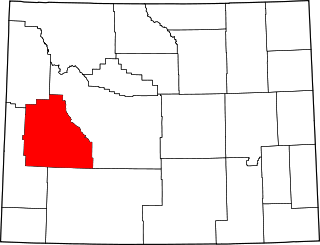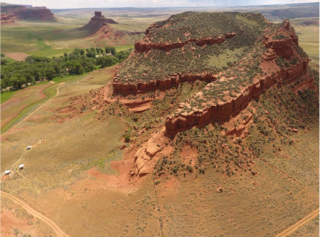Related Research Articles

The Medicine Wheel/Medicine Mountain National Historic Landmark is a medicine wheel located in the Bighorn National Forest, in the U.S. state of Wyoming. The Medicine Wheel at Medicine Mountain is a large stone structure made of local white limestone laid upon a bedrock of limestone. It is both a place of sacred ceremony and scientific inquiry. In Native Science these uses are not distinguished as separate as they are in Western science.

Colter's Hell is an area of fumaroles and hot springs on the Shoshone River near Cody in the U.S. state of Wyoming. The thermal area covers about one square mile (2.6 km2) at the mouth of the Shoshone's canyon. Its thermal activity has declined since its description by mountain man John Colter, who parted from the Lewis and Clark Expedition prior to its conclusion, and passed through the region in the winter of 1807–1808. Colter's account of the features on what was then called the Stinkingwater River has subsequently been confused with the much more extensive and powerful geysers in Yellowstone National Park, which Colter may not have actually visited.
The Bridger Antelope Trap is an archaeological site in Uinta County, Wyoming, associated with local Indigenous hunting practices. As an important example of hunting and gathering strategies, the site provides important clues to native subsistance in the past. The Wyoming State Historic Preservation Office nominated the antelope trap for the National Register of Historic Places (NRHP). The NRHP added the site to the Register on 21 January 1971.

The Lindenmeier site is a stratified multi-component archaeological site most famous for its Folsom component. The former Lindenmeier Ranch is in the Soapstone Prairie Natural Area, in northeastern Larimer County, Colorado, United States. The site contains the most extensive Folsom culture campsite yet found with calibrated radiocarbon dates of c. 12,300 B.P.. Artifacts were also found from subsequent Archaic and Late pre-historic periods.
George Carr Frison was an American archaeologist. He received the Society for American Archaeology's Lifetime Achievement Award, the Paleoarchaeologist of the Century Award, and was elected to the National Academy of Sciences. He was Wyoming’s first State Archaeologist, and was a founder of the University of Wyoming Anthropology Department. He died in September 2020 at the age of 95.

William Thomas Mulloy Jr. was an American anthropologist. While his early research established him as a formidable scholar and skillful fieldwork supervisor in the province of North American Plains archaeology, he is best known for his studies of Polynesian prehistory, especially his investigations into the production, transportation and erection of the monumental statuary on Rapa Nui known as moai.
The Horner site, also known as the Creek site and Horner's Corner site, and designated by the Smithsonian trinomial 48PA29, is an important archaeological site near Cody, Wyoming, United States. It is the type site for the Cody complex. It was declared a National Historic Landmark in 1961.

Ten Sleep Mercantile, also known as Ten Sleep Hardware, is an example of a typical small-town general store. Located in Ten Sleep, Wyoming, it has been the focal point of the town since it was built in 1905 by H.T. Church. Upon Church's death in 1918 the property was bought by Buffalo businessman and rancher Alex Healy (Rancher) in an agreement that brought the store under the control of Paul Frison. Frison, who later served as mayor of Ten Sleep and as a Wyoming state legislator, operated the store from 1918 to 1943.

This is a list of the National Register of Historic Places listings in Big Horn County, Wyoming.

This is a list of the National Register of Historic Places listings in Sublette County, Wyoming. It is intended to be a complete list of the properties and districts on the National Register of Historic Places in Sublette County, Wyoming, United States. The locations of National Register properties and districts for which the latitude and longitude coordinates are included below, may be seen in a map.

This is a list of the National Register of Historic Places listings in Campbell County, Wyoming. It is intended to be a complete list of the properties and districts on the National Register of Historic Places in Campbell County, Wyoming, United States. The locations of National Register properties and districts for which the latitude and longitude coordinates are included below, may be seen in a map.
The Dead Indian Campsite is an archeological site in the Sunlight Basin of the Absaroka Mountains in Park County, Wyoming, United States. The site was found during the construction of the Sunlight Basin Road in 1967. The location was used as a butchering site, and excavations by the University of Wyoming in 1969 uncovered numerous stone tools, as well as the bones of elk, deer, mountain sheep, porcupine and wolf. A stone cairn was found to contain antler sets. The site was used in different eras for 4500 years.

The Vore Buffalo Jump is an archeological site in Crook County, Wyoming. A sinkhole formed where gypsum soil was eroded, leaving a steep-sided pit about 40 feet (12 m) deep and 200 feet (61 m) in diameter. Native American hunters could stampede bison in the direction of the pit, which was deep enough to kill or disable the animals that were driven into it. The location is one of a number of buffalo jump sites in the north central United States and southern Canada. The Vore site was used as a kill site and butchering site from about 1500 AD to about 1800 AD. Archeological investigations in the 1970s uncovered bones and projectile points to a depth of 15 feet (4.6 m). About ten tons of bones were removed from the site. About five percent of the site has been excavated, and the pit is estimated to contain the remains of 20,000 buffalo.
The Wardell Buffalo Trap in Sublette County, Wyoming is a small box canyon used by Native Americans for 500 years during the Late Prehistoric Period. Nearly 55 feet (17 m) of bison bones were found at the site. A campsite and butchering area is located nearby, and evidence has been found for a fence at the entrance to the canyon.
The Jurgens Site is a Paleo-Indian site located near Greeley in Weld County, Colorado. While the site was used primarily to hunt and butcher bison antiquus, there is evidence that the Paleo-Indians also gathered plants and seeds for food about 7,000 to 7,500 BC.
Hell Gap is a deeply stratified archaeological site located in the Great Plains of eastern Wyoming, approximately thirteen miles north of Guernsey, where an abundant amount of Paleoindian and Archaic artifacts have been found and excavated since 1959. This site has had an important impact on North American archaeology because of the large quantity and breadth of prehistoric Paleoindian and Archaic period artifacts and cultures it encompasses. It was designated a National Historic Landmark in 2016.
The Hanson Site includes two separate areas of Paleoindian acheological sites in the northern Bighorn Basin of Wyoming, United States. The southern Hanson I site was investigated first in 1973, finding evidence of tool working and stone flakes at a campsite. The northern Hanson II site is larger and includes the sites of lodges. Activity in these areas dates to 10,700 +/- 670 years ago to 10,080 +/- 300 years ago. The Hanson site is also of interest in paleontology, with animal fossil remains at deeper levels. The site was placed on the National Register of Historic Places on December 15, 1978.
The Garrett Allen Prehistoric Site is an archeological site in Carbon County, Wyoming. The site was used in the Late Middle Prehistoric Period and into the Late Prehistoric Period. The site was used as an animal butchering location. Excavations by George Frison in the late 1960s and early 1970s revealed a continuous series of layers containing tools, stone flakes and projectile points. This site was placed on the National Register of Historic Places on August 7, 1974.

The Jameson Site in Johnson County, Wyoming is an archeological site which was listed on the National Register of Historic Places in 2018.
References
- 1 2 "National Register Information System". National Register of Historic Places . National Park Service. March 13, 2009.
- ↑ "Agate Basin Site". National Register of Historic Places. Wyoming State Preservation Office. March 26, 2020.